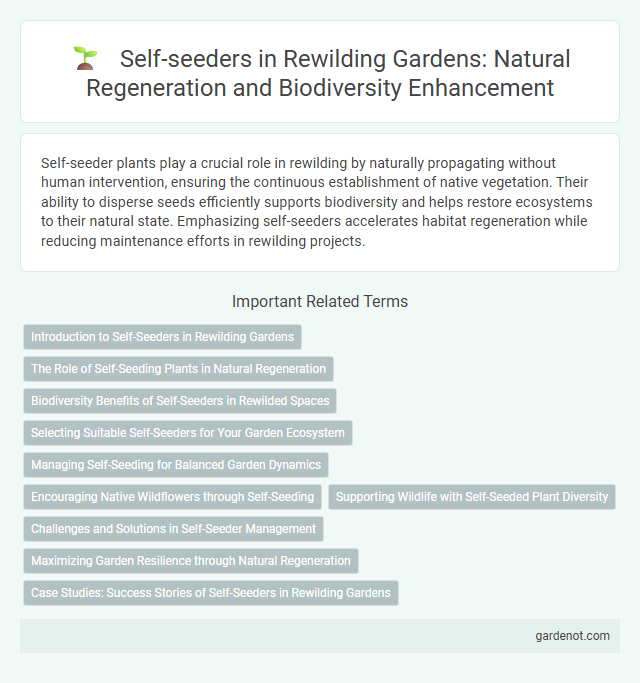Self-seeder plants play a crucial role in rewilding by naturally propagating without human intervention, ensuring the continuous establishment of native vegetation. Their ability to disperse seeds efficiently supports biodiversity and helps restore ecosystems to their natural state. Emphasizing self-seeders accelerates habitat regeneration while reducing maintenance efforts in rewilding projects.
Introduction to Self-Seeders in Rewilding Gardens
Self-seeders are plants that naturally disperse seeds and regenerate without human intervention, playing a crucial role in rewilding gardens by promoting biodiversity and ecological resilience. These species enhance habitat complexity by creating layered vegetation and supporting pollinators, birds, and beneficial insects. Incorporating self-seeders in rewilding efforts reduces maintenance requirements and encourages the development of sustainable, dynamic ecosystems.
The Role of Self-Seeding Plants in Natural Regeneration
Self-seeding plants play a crucial role in natural regeneration by enabling ecosystems to recover without human intervention. These species disperse seeds autonomously, facilitating spontaneous growth and biodiversity restoration in degraded habitats. Their ability to establish resilient plant communities supports soil health, enhances wildlife habitats, and promotes long-term ecological balance.
Biodiversity Benefits of Self-Seeders in Rewilded Spaces
Self-seeders enhance biodiversity in rewilded spaces by naturally propagating native plant species, creating diverse habitats that support various wildlife. Their ability to establish resilient plant communities improves soil health and ecosystem stability, fostering a balanced and sustainable environment. By promoting genetic diversity and ecological interactions, self-seeders contribute to the regeneration of complex food webs critical for thriving ecosystems.
Selecting Suitable Self-Seeders for Your Garden Ecosystem
Selecting suitable self-seeders for your garden ecosystem involves identifying native plants that thrive in local soil and climate conditions while promoting biodiversity. Species like wildflowers, grasses, and shrubs with high seed viability and minimal maintenance needs are ideal for rewilding efforts. Prioritize plants that support pollinators and wildlife, ensuring a sustainable, balanced habitat that enhances ecosystem resilience.
Managing Self-Seeding for Balanced Garden Dynamics
Managing self-seeding plants is essential for maintaining balanced garden dynamics, as these species naturally propagate without human intervention. Regular monitoring and selective thinning prevent overcrowding and ensure diverse plant composition, promoting ecosystem health. Employing strategic mulching and timely removal of excess seedlings supports controlled growth while preserving the benefits of natural regeneration.
Encouraging Native Wildflowers through Self-Seeding
Encouraging native wildflowers through self-seeding enhances biodiversity by allowing plants to naturally propagate and establish resilient habitats. Self-seeding species like Echinacea purpurea, Asclepias tuberosa, and Rudbeckia hirta adapt well to local soil and climate conditions, supporting pollinators such as bees and butterflies. Promoting these native wildflowers reduces the need for replanting efforts and fosters sustainable, low-maintenance ecosystems essential for successful rewilding projects.
Supporting Wildlife with Self-Seeded Plant Diversity
Self-seeded plants play a crucial role in rewilding efforts by promoting natural regeneration and enhancing habitat complexity. These plants support diverse wildlife populations by providing essential food sources and shelter, fostering greater ecosystem resilience. Incorporating self-seeders into restoration projects ensures sustainable plant diversity that benefits pollinators, birds, and small mammals year-round.
Challenges and Solutions in Self-Seeder Management
Self-seeders pose challenges in rewilding projects due to unpredictable germination patterns and competition with desired native species. Effective management solutions include the use of selective weeding, targeted disturbance regimes to favor native flora, and monitoring seed bank dynamics to promote desirable regeneration. Incorporating adaptive management strategies ensures balance between self-seeding success and ecosystem restoration goals.
Maximizing Garden Resilience through Natural Regeneration
Self-seeders play a crucial role in maximizing garden resilience by naturally regenerating diverse plant populations without human intervention. By allowing native species to drop seeds and establish themselves, the ecosystem strengthens its ability to withstand pests, diseases, and climate fluctuations. This process enhances soil health and biodiversity, creating a robust and self-sustaining garden environment.
Case Studies: Success Stories of Self-Seeders in Rewilding Gardens
Self-seeder plants like foxglove (Digitalis purpurea) and columbine (Aquilegia vulgaris) demonstrate remarkable success in rewilding garden projects, naturally regenerating without human intervention. Case studies from the Knepp Estate in England highlight how these self-seeders contribute to increased biodiversity, supporting pollinators and native wildlife by creating diverse plant communities. Their resilience and adaptability make self-seeders an essential component in restoring ecological balance in rewilding initiatives.
Self-seeder Infographic

 gardenot.com
gardenot.com